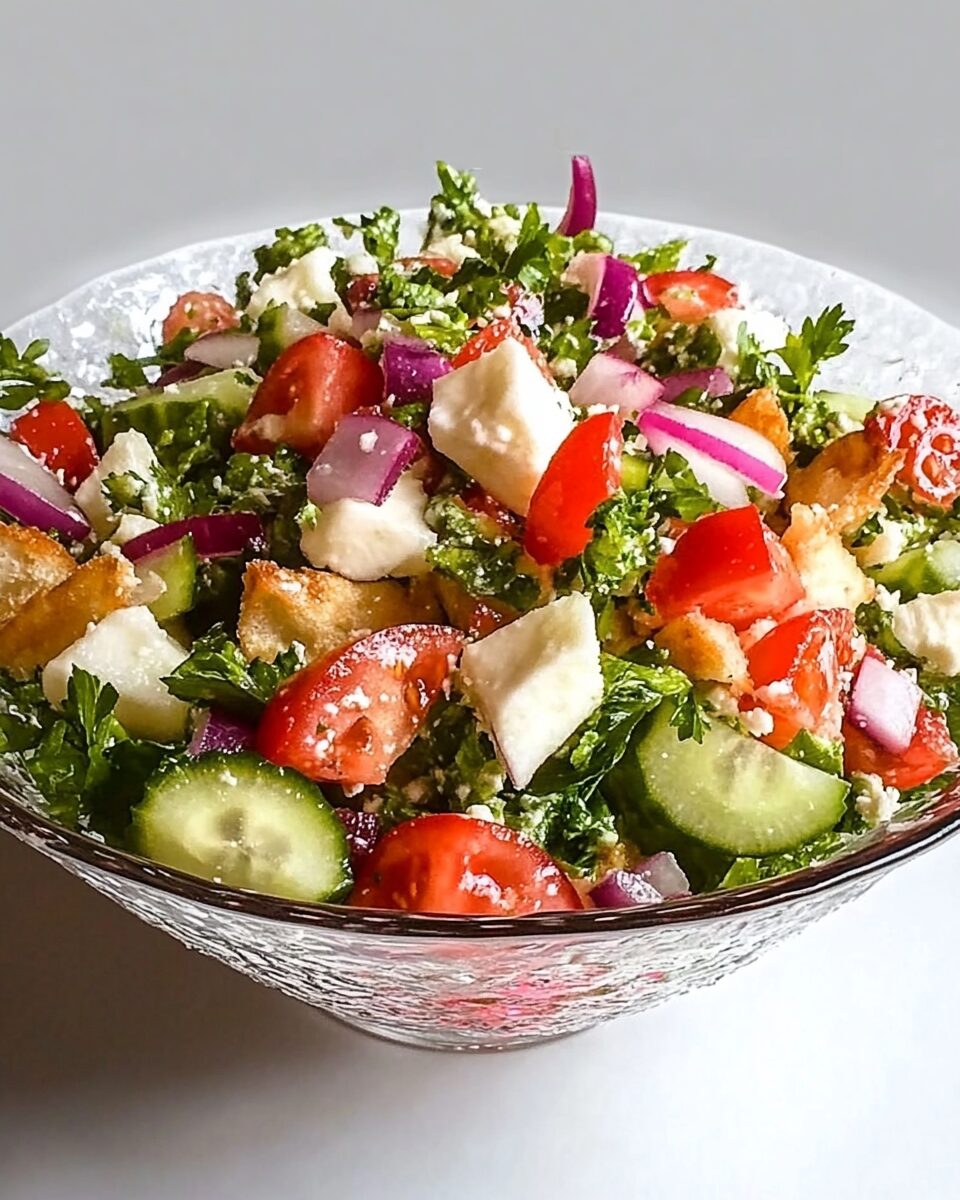Arabic Fattoush Salad is a traditional Middle Eastern salad that combines fresh vegetables with crispy pieces of pita bread, all tossed in a tangy dressing. Whether served as a side dish, a light meal, or part of a mezze platter, Fattoush is a versatile and crowd-pleasing salad that continues to be a favorite in Middle Eastern cuisine.
Full Recipe:
Ingredients
- 1 tablespoon vegetable oil, for frying
- 2 small (4-inch) pita breads, torn into pieces
- 1 large English cucumber, finely diced
- 3 cups halved grape tomatoes
- ¾ cup chopped Italian parsley
- ¾ cup chopped fresh mint
- ½ red onion, finely diced
- 2 tablespoons extra-virgin olive oil, or to taste
- 1 tablespoon fresh lemon juice, or to taste
- 1 teaspoon ground sumac, or to taste
- 1 clove garlic, crushed, or more to taste
- Kosher salt and freshly ground black pepper to taste
- 1 ounce sheep’s milk feta cheese
Directions
- Heat the vegetable oil in a large skillet over medium-high heat. Working in batches, fry the pita pieces until golden brown on both sides. Blot dry with paper towels and set aside.
- In a large serving bowl, combine the cucumber, tomatoes, parsley, mint, red onion, olive oil, lemon juice, sumac, garlic, kosher salt, and black pepper. Gently toss the salad with the fried pita pieces.
- Grate the feta cheese over the salad using a small cheese grater to serve.
Nutritional Facts
Per serving:
- Calories: 169
- Total Fat: 9g
- Saturated Fat: 2g
- Cholesterol: 6mg
- Sodium: 208mg
- Total Carbohydrate: 19g
- Dietary Fiber: 3g
- Sugars: 6g
- Protein: 5g
- Vitamin C: 40mg
- Calcium: 107mg
- Iron: 2mg
- Potassium: 549mg
The Origins and History of Fattoush
Fattoush is believed to have originated in the Levant region, particularly in Lebanon and Syria. The name itself comes from the Arabic word “fatt,” which means “to crumble” or “break apart,” referring to the way pieces of pita bread are broken and mixed into the salad.
Historically, Fattoush was a practical dish created by farmers who used leftover stale pita bread and combined it with fresh vegetables from their gardens. By adding sumac and lemon juice, they created a tangy dressing that complemented the flavors perfectly. Over time, the dish became a staple in Middle Eastern cuisine and is now enjoyed worldwide for its refreshing taste and simple preparation.
Why Fattoush is Unique
What sets Fattoush apart from other salads is the addition of fried or toasted pita bread. While many salads rely on croutons or nuts for texture, Fattoush incorporates pita, which soaks up the flavorful dressing while still maintaining a crispy bite.
Another defining characteristic of Fattoush is its use of sumac, a tangy, deep-red spice made from dried sumac berries. Sumac adds a slightly citrusy, tart flavor to the dressing, making it distinct from other vinegar-based salad dressings. This unique seasoning gives Fattoush its signature taste and enhances the overall freshness of the dish.
Health Benefits of Fattoush Salad
Fattoush is not only delicious but also packed with numerous health benefits. The fresh vegetables and herbs provide essential vitamins and minerals, making it a nutritious addition to any meal. Here are some of the key health benefits:
- Rich in Vitamins and Antioxidants: The tomatoes, cucumbers, and leafy greens in Fattoush are excellent sources of vitamins A, C, and K, which promote immune health, vision, and bone strength.
- High in Fiber: The inclusion of fresh vegetables and whole wheat pita bread provides dietary fiber, aiding digestion and promoting gut health.
- Low in Calories: Fattoush is naturally low in calories, making it a great option for those looking to maintain a healthy weight while still enjoying a satisfying meal.
- Heart-Healthy Ingredients: Olive oil, a key component of the dressing, contains healthy monounsaturated fats that support heart health and help reduce bad cholesterol levels.
- Hydrating and Refreshing: The high water content in cucumbers and tomatoes helps keep the body hydrated, making this salad perfect for warm climates or summer meals.
Variations of Fattoush Salad
While the traditional recipe remains popular, there are several variations of Fattoush that cater to different tastes and preferences. Here are some of the most common adaptations:
- Grilled Pita Fattoush: Instead of frying the pita, some people prefer to grill or toast it for a healthier alternative. This adds a smoky depth of flavor while keeping the bread crispy.
- Pomegranate Fattoush: Adding pomegranate seeds or pomegranate molasses enhances the salad with a sweet and tangy twist. This variation is especially popular in Syrian and Lebanese cuisine.
- Spicy Fattoush: For those who enjoy a bit of heat, finely chopped chili peppers or a dash of cayenne pepper can be added to the dressing.
- Cheese-Topped Fattoush: Some versions include crumbled feta cheese for an extra layer of creaminess and saltiness.
- Protein-Packed Fattoush: To make it a complete meal, grilled chicken, shrimp, or chickpeas can be added for a protein boost.
Best Ways to Serve Fattoush
Fattoush is an incredibly versatile salad that pairs well with many dishes. Here are some of the best ways to serve it:
- As a Mezze Dish: Fattoush is commonly served as part of a mezze spread, alongside dishes like hummus, baba ghanoush, and tabbouleh.
- With Grilled Meats: The bright and tangy flavors of Fattoush complement grilled meats such as lamb, chicken, or beef kebabs.
- As a Side Dish: It pairs well with Middle Eastern rice dishes, such as mujaddara (lentil and rice pilaf) or pilaf with nuts and dried fruits.
- As a Light Meal: On its own, Fattoush makes for a light and refreshing meal, especially when topped with protein.
Tips for Making the Best Fattoush
To ensure your Fattoush turns out perfectly every time, follow these expert tips:
- Use Fresh Ingredients: Since Fattoush relies on fresh vegetables, always choose the ripest tomatoes, crisp cucumbers, and fragrant herbs.
- Let the Flavors Marinate: Allow the salad to sit for a few minutes before serving. This helps the dressing soak into the vegetables and enhances the overall taste.
- Don’t Over-Soak the Pita: Add the pita bread just before serving to maintain its crisp texture. If left too long, it may become too soggy.
- Adjust the Dressing to Taste: The balance of olive oil, lemon juice, and sumac can be adjusted depending on your preference for tanginess.
How to Store Fattoush Salad
Fattoush is best enjoyed fresh, but if you have leftovers, here’s how to store it properly:
- Refrigerate Without Pita: Store the salad and dressing separately from the pita bread to prevent sogginess. Add the pita just before serving.
- Consume Within 24 Hours: Fattoush tastes best when eaten within a day, as the vegetables may lose their crispness over time.
- Refresh with More Dressing: If the salad becomes dry after refrigeration, simply add a little more lemon juice or olive oil before serving.
Conclusion
Arabic Fattoush Salad is a vibrant and refreshing dish that brings together the best flavors of the Middle East. With its crisp vegetables, crunchy pita, and tangy sumac dressing, it offers a perfect balance of texture and taste. Not only is it delicious, but it also provides a wealth of health benefits, making it an excellent choice for anyone looking to incorporate more fresh, wholesome ingredients into their diet.






